 |
Inspiring a Nation: The Story of the Hellís Angels |
Personnel
Mission Reports
by Brian Rukes
written in Fall 1998 for a Historical Research and Writing Class
as a student at Southwestern Oklahoma State University in Weatherford, Oklahoma
(based on interviews with Capt Irl E. Baldwin and M/Sgt Fabian S. Folmer)

The Boeing B-17F-25-BO which became known as the Hellís Angels was one of the most notable aircraft that participated in World War II. This aircraft started out as just an ordinary bomber, and it was no more special than other such B-17s at the time. However, the actions of the persons associated with Hellís Angels made the aircraft unique and its presence significant. Hellís Angels came to serve as a symbol of those persons, and that symbol inspired others to work harder and strive for the best. It inspired a nation to win a war.
The United States Army Air Corps activated the 303rd Bombardment Group, which the B-17 Hellís Angels would later become a part of, on 3 February 1942 at Gowen Field in Boise, Idaho. Shortly thereafter, the 303rd began its training for overseas combat duty. June 1942 found the group on the move, settling at Alamogordo Air Base in New Mexico. Then, four months later, the air echelon of the 303rd Bomb Group flew to Biggs Field in El Paso, Texas (1).
Boeing produced B-17 heavy bombers of the version B-17F-25-BO at this time. Boeing gave one of these the Boeing manufacturing number 3262, and the U.S. Army Air Corps gave that same aircraft number 41-24577. Boeing delivered this nameless B-17F, which would become known as Hellís Angels, on 13 August 1942 to Wright Field (2).
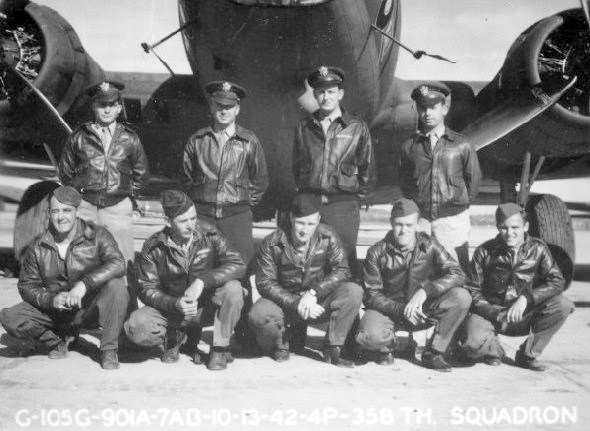
During September 1942, Captain Irl E. Baldwin and his crew in the 303rd Bombardment Groupís 358th Bombardment Squadron traveled to Cheyenne, Wyoming. There, at the United Airlines modification center, they picked up a brand new B-17F, #41-24577 (3).
Flying in their B-17s, the air echelon of the 303rd Bombardment Group went to Kellogg Field in Battle Creek, Michigan, in late October 1942. There the 303rd assigned its four bombardment squadrons new B-17Fs. B-17F #41-24577 became a 358th Bombardment Squadron aircraft, and Captain Baldwin and his men became its crew. Master Sergeant Fabian Folmer received orders to serve as ground crew chief on Baldwinís aircraft.
The 303rd then gave its crews the opportunity to name their B-17s. However, at that time, the Baldwin crew could not decide on a name. Various crew members proposed different names for #41-24577, but none of them suited the entire crew. So, B-17F-25-BO #41-24577 remained nameless (4).
The 303rd air crews then flew to Dow Field in Bangor, Maine--their last stateside stop. There, the ground crew modified aircraft #41-24577 like no other B-17 had been modified before. They started installing a special gun mount in the aircraftís plexiglass nose cone. This enabled the aircraft to have some defense against frontal attacks by German fighters. However, they did not complete the modification by the time the crews of the 303rd left Dow Field and headed overseas. The mount was there and stable, but gaps remained around the mount in the nose cone, allowing air to enter the nose of the aircraft. This fact did not hurt the aircraftís maneuverability, but it would eventually be the source of at least one problem for a few members of the Baldwin crew.
The 303rdís flight to Europe included numerous stops for refueling and rest. First stopping at Gander FIeld in Newfoundland, the crews checked their aircraft for any deficiencies before making the remainder of the flight to the United Kingdom. Departing from Gander Field, the group next stopped momentarily at Icelandís capital city. They then flew on to Prestwick, Scotland. From there, the crews of the 303rd embarked on the final leg of their journey. Baldwinís crew and aircraft arrived at their new home, the Molesworth Airdrome in Cambridgeshire, England, on 24 October 1942 (5). Baldwinís crew were not seasoned veterans of the war by that time, so on the surface they were still no different than any other air crew in Europe at the time. Still, they possessed something a little different, but it would take the taste of battle to extract it from them.
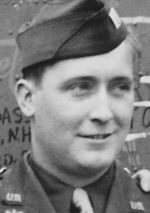 Capt Irl E. Baldwin |
Even though #41-24577 remained nameless at this time, that soon changed. During one early mission, Captain Baldwin spoke to his crew over the aircraftís intercom with regard to what they should name their Flying Fortress. Baldwin, who enjoyed the World War I flight-related movie Hellís Angels, asked, ďHow about Hellís Angels?Ē One crew member responded, ďThis is the closest to hell that angels will ever get!Ē The rest of the crew then checked in one by one, all agreeing on the name (7).
So was born the name Hellís Angels. Private First Class Bernard K. ďBernieĒ Kastenbaum designed and painted the original artwork on the right side of the Hellís Angelsí fuselage late in 1942. The original artwork consisted of the words ďHellís AngelsĒ painted beneath an angel on roller skates holding a bomb above its head. The 303rd Bomb Group then issued orders that the group would have to paint aircraft identification letters on the sides of each of its aircraft. Kastenbaumís artwork was in the way, and it had to be removed as a result. In Kastenbaumís absence (8), Staff Sergeant Harold Godwin, then the tail gunner on Baldwinís crew, painted the words ďHELLíS ANGELSĒ on both sides of the aircraftís nose in the location that became familiar to everyone. Godwin omitted the artwork of the angel on roller-skates; that would be added much later, sometime around the Hellís Angelsí completion of forty missions (9).
Having completed a few missions, certain Hellís Angels crew members noticed there was a problem associated with the holes that were left unfilled when the special gun mount was earlier installed in their B-17ís nose. Frigid air entered the hose of the aircraft at cruising altitude through those gaps, first affecting the bombardier and navigator who were stationed in the nose. Then the frigid air worked its way back into the cockpit, annoying the pilot and copilot. Baldwin remembers that he wanted to shut the door between the cockpit and nose section, but he was under orders to leave that door open while in flight. Eventually, the holes in the nose were filled (10).
After completing a few missions, Captain Baldwin agreed with his crew that they would never turn back from any mission if it could be avoided. To achieve their goal, Baldwin and his crew knowingly did a variety of things that were against the rules. Knowing the Eighth Air Forceís desperation for manpower at the time, they felt they had a responsibility to the other crews in the European Theater of Operations to be in the air whenever possible. Their intent was not to be heroes or to set records; they were just trying to do their jobs to the best of their abilities (11).
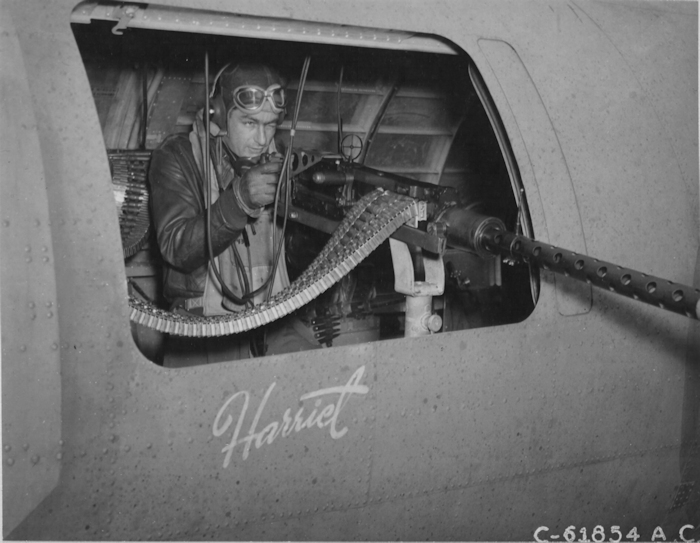
Hell's Angels' Right Waist Gunner S/Sgt Dennis Weiskopf
One of the things the crew of the Hellís Angels broke the rules on involved their guns. It was a common problem with the .50-caliber machine guns to freeze up, rendering them inoperable, at altitude (around 20,000 feet above sea level) (12). As a result, the 303rd Bombardment Group ordered its crews to abort any mission in which three or more of its eleven guns were inoperative. However, according to Baldwin, he and the crew disobeyed this order often. Once, only three of their guns were operative, the other eight being frozen or jammed. Baldwinís crew justified their actions by believing that there were enough guns in the formation of Flying Fortresses to protect them, as well.
On other occasions, the Hellís Angels completed missions under the control of Captain Baldwin when it mechanically could have aborted. On one mission, Baldwinís flight engineer alerted him that he heard one engine running rough whenever Baldwin throttled it back. Baldwin experimented and discovered that the flight engineer was correct. However, Baldwin was still capable of maintaining the Hellís Angelsí position in the formation of B-17s, so he pressed on. After landing back at Molesworth, the Hellís Angelsí ground crew discovered the problem--one of the spark plugs had either blown or fallen out of the engine in question (13).
On another mission, Captain Baldwin discovered that one of the engines on #41-24577 had a runaway turbo supercharger as the Hellís Angels climbed to altitude to join the formation of the 303rdís Flying Fortresses. With experimentation, Baldwin found that by setting the runaway control all the way down on the engine in question that it would run reasonably. The Hellís Angels completed this mission, as well (14).
Indicative of the dedication of the Baldwin crew to not aborting any mission unless fully necessary, Baldwin recalled the actions of two of his gunners on one mission. On that mission, the guns of both the tail gunner and one of the waist gunners on the Hellís Angels jammed. Both gunners took off their gloves to try to break their jams, and, in the process, both men froze their hands. Both men knew that if Baldwin found out that they had frozen their hands, he would abort the mission. Since neither man wanted to be the cause of the Hellís Angelsí first abort, they waited to tell Baldwin about their hands until they landed back at Molesworth. Captain Baldwin, under orders, gave both gunners an oral reprimand for their actions. The gunners were in the hospital for two weeks due to freezing their hands; neither manís hands had permanent damage (15).
Captain Baldwin took particular pride in flying the Hellís Angels. In February 1943, Baldwin and the rest of the Hellís Angels crew were on leave in London. While its regular combat crew was on leave, the Hellís Angels completed two missions on two consecutive days, the 26th and 27th of February 1943. Baldwinís crew members heard this, and they terminated their leaves at once to return to base. Baldwin marched into headquarters and argued with the Operations Officer over someone else getting to fly his crewís aircraft; Baldwin lost the argument (16).
The Hellís Angels became the first B-17 in the European Theatre of Operations to complete twenty-five missions on 13 May 1943. The target was the Potes Aircraft Factory at Meaulte, France. Baldwin pointed out that by that time, the 303rd Bombardment Group and the Hellís Angels crew had only been in Europe eight months. In that time, the 303rdís losses included twenty-seven of its original thirty-five crews. Making it back to base even a few times was remarkable in itself in the early days of the air war, and many crews considered completing a twenty-five mission combat tour-of-duty almost impossible. The Hellís Angelsí completion of twenty-five missions gave hope to thousands of people, as a result (17).
The U.S. Army Air Force still did not select the Hellís Angels to return to the United States despite its accomplishments to date. Many members of the Baldwin crew remained in Europe, as well. However, the crewís reason was different. Individually, they still lacked a few missions each to complete their own tours-of-duty.
The next mission, of 14 May 1943, was a significant mission for the Hellís Angels and its crew. The target was the submarine pens at Kiel, Germany; this was the first 303rd Bombardment Group raid on Kiel. Additionally, Hellís Angels led the entire formation for its first time. First Lieutenant Donald R. Bone served as bombardier aboard #41-24577, and the entire group dropped its bombs on his lead. Bone indicated that his bombs ďabsolutely split the target,Ē and overall the entire groupís raid devastated Kiel. Baldwin completed his combat tour on this mission, becoming one of the first pilots in the European Theater of Operations to accomplish that feat. Baldwin received the Distinguished Flying Cross as a result (18).
With its original air crew returning to the United States one-by-one, the Hellís Angels continued to have bombs painted on its nose as it completed more combat missions. No longer was one crew normally assigned to fly Hellís Angels; Headquarters randomly assigned crews to fly different aircraft for each mission. Still, one group claimed Hellís Angels as its own: the ground crew.
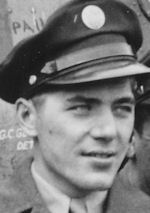 M/Sgt Fabian S. Folmer |
With time, supplies and better tools became readily available, but the ground crew still did not have it easy. They toiled in the mud, grease, fog, cold air, and the black of night. Once the crew worked twenty-seven hours without a break in order to have #41-24577 ready for the next mission. Furthermore, they set a record of completely changing out an engine in ten hours. Still, the ground crew of the Hellís Angels was not alone. Whenever there was any doubt that the aircraft might not be ready in time for the next mission, the air crew worked alongside the ground crew. The lives of the air crew depended on the ground crew, resulting in a strong bond between the two groups (20).
Just as the Hellís Angels air crew broke the rules to keep their B-17 in the air, so did its ground crew. Sergeant John R. Kosilla was the ground crewís ďburglar.Ē Whenever Hellís Angels needed replacement parts, Kosilla did a little ďmoonlight requisitioning,Ē taking the needed parts off of other aircraft that were not airworthy at the time. Other ground crews did the same things, but Kosilla was more honest in his actions. When he took a part, he left a note; he later gave back the parts he took (21).
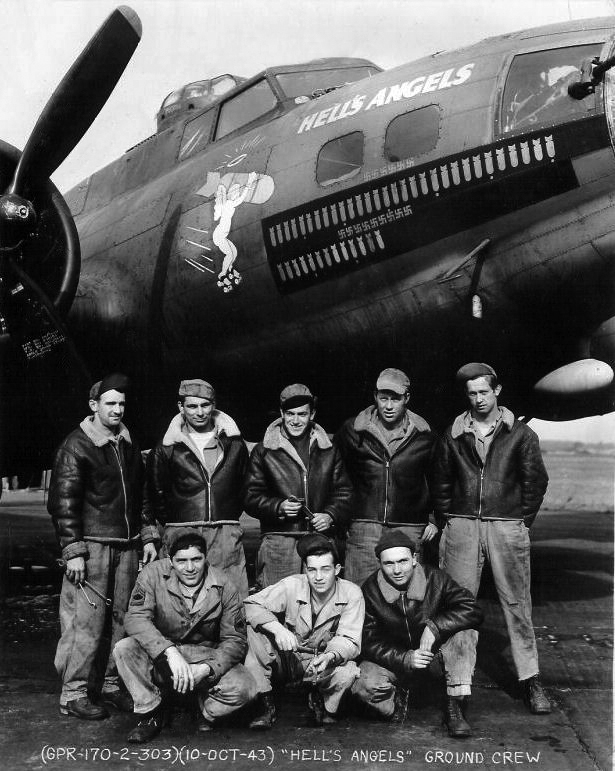
The combined efforts of the ground crew and the combat crews that flew in the Hellís Angels resulted in the aircraft setting yet another record. On 27 August 1943, it became the first B-17 to complete forty combat missions without an abortion due to mechanical failures or personnel problems. This inspired other ground crews to strive for the best and work harder. As a result, Folmer received the Legion of Merit, becoming the first crew chief to be given that honor (27).
The Hellís Angelsí record of dependability was impressive, but the bomber would soon have to turn back due to mechanical failure. On the mission of 31 August 1943, one of the piston rings in #41-24577ís number three engine cracked. This caused oil to leak from the engine and cover the right wing of the Flying Fortress, forcing Lieutenant Gamble to abort Hellís Angels for the first time (23). William McSween served as navigator on the Gamble crew that day, and he recalled not being welcome when their aircraft returned to base early. He commented that everyone in the 303rd had big plans for the Hellís Angels to be the first B-17 to complete fifty missions without aborting (24).
The Hellís Angels was still in the midst of a fierce competition at the Molesworth Airdrome. It was one of three 303rd Bombardment Group B-17s in a race to be the first to finish fifty combat missions. Hellís Angels lost this race, as the Knockout Dropper of the 359th Bombardment Squadron completed its fiftieth mission on 16 November 1943. At that time, #41-24577 claimed only forty-seven missions completed (25).
Americans by this time started to recognize the 303rd Bomb Group as one of the most famous bomb groups in the war due to the numerous accomplishments its men and aircraft achieved. Thus, the group decided it needed a name for publicity affairs and asked for suggestions. The 303rd then decided on 7 January 1944 that ďHellís Angels Bomb GroupĒ was most appropriate. They took the name directly from B-17 #41-24577 simply because it was one of the groupís original aircraft that had an impressive record of dependability and mechanical efficiency up to that point. The nose art of the Hellís Angels, including the angel on rollerskates, thereafter represented the 303rd, too (26).
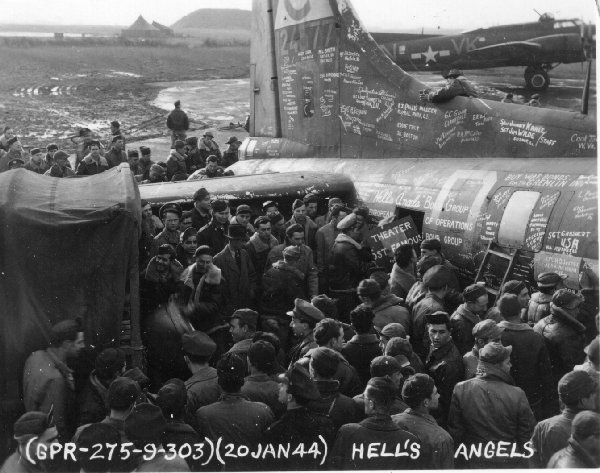
20 Jan 1944 - Signing Names on Hell's Angels for her US Tour
The U.S. Army Air Force selected Hellís Angels and its ground crew to return to the United States following the bomberís completion of forty-eight combat missions. Touring stateside war factories in order to boost worker morale was the new assignment for the Hellís Angels and its men. On 20 January 1944, the 303rdís group commanding officer allowed anyone who wanted to to sign the Hellís Angels before it left Molesworth for the states. Hundreds of men then blanketed the battle-scarred bomber with signatures in white paint. Then, the group held a Hellís Angels farewell ceremony. Present was Lieutenant Colonel Ben Lyons, a public relations officer on the staff of General Ira Eaker, commander of the Eighth Air Force. Also, Lyons had starred in the movie Hellís Angels from which the bomber--and eventually bomb group--took its name. The Hellís Angels, with its entire ground crew plus six combat crewmen aboard, took off from the Molesworth Airdrome under an archway of flares after the ceremony (27).
Back in the United States, the Hellís Angels first stopped at Tinker Field in Oklahoma City, Oklahoma. A marching band, guard of honor, and five thousand other people greeted the veteran bomber when it landed there. The size of the crowd intimidated the ground crew members aboard Hellís Angels. After exiting the B-17, the ground crew ventured no further and stayed close together. Then, Captains Baldwin and Bone of the original air crew burst through the guard line, causing the fear to leave the ground crew. The ground crewmen smiled, saluted, and threw their arms around the Captains that had been like brothers to them. Baldwin joined the ground crew and participated in the remainder of the industrial morale tour (28).
What the men aboard the Hellís Angels experienced at Oklahoma City, they would experience often during their stateside tour. Thousands of enthused individuals greeted them everywhere they stopped, and they spoke to just as many exhausted workers in the U.S. war factories. The goal of the tour was to make those same workers toil harder. According to Charles A. Rawlings, a writer for the Saturday Evening Post, one man told Folmer and the rest of the crew that:
ďWe want to make these people feel as you did when you were working over thereÖ We canít do it by criticizing them or crying ĎShame.í They are already working very hard, but weíve got to ask them to work harder. That is what you boys did when the need was there. Tell them how hard it was at first because you did not have the things you needed. How important what they are doing is; how you and all the thousands like you need the things they are making desperatelyÖ Put Ďem in the war. Go on. You can do it better than fifty generalsĒ (29).Those things they told the workers, but they didnít stop there. They told the workers that no man ever died or received a combat wound flying in the Hellís Angels, which many regarded as the most noteworthy claim one could make about the bomber. The men also pointed out the patches that blanketed the veteran B-17, covering the hundreds of bullet holes and numerous flak holes that Hellís Angels sustained in battle.
The Hellís Angelsí industrial morale tour had just begun. Departing from Tinker Field, the bomber flew to Wright-Patterson Air Force Base where it received an overhaul before it embarked on the rest of the tour. Then, Hellís Angels stopped at an engine plant in Trenton, New Jersey, and at two Timken Roller Bearing plants in Ohio. In Indiana, the bomber made a stop at a Studebaker Corporation plant, and it visited ball bearing plants in Chicago, Illinois. Hellís Angels visited a sub depot in Cheyenne, Wyoming, too. In Washington state, the bomber stopped at Yakima and then the Boeing plant where it originated. The tour ended at Los Angeles, California (30).
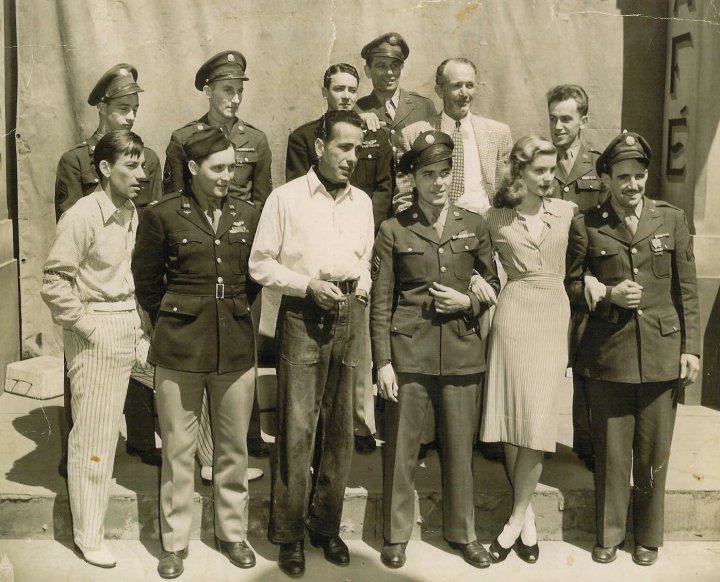
Humphrey Bogart Group - Hell's Angels Bond Tour - February 1944
(Back L-R)
S/Sgt Ernest H. Touhey,
S/Sgt Edward A. West, Jr,
Capt John R. Johnston,
S/Sgt John R. Kosilla,
Walter Brennan,
S/Sgt Kasmer Wegrzyn
(Front L-R)
Hoagie Carmichael,
Capt Irl Baldwin,
Humphrey Bogart,
T/Sgt Fabian S. Folmer,
Lauren Bacall,
Sgt Wilson F. Fairfield
Following the successful industrial morale tour, the history of Hellís Angels becomes sketchy. Some people remembered being trained in the veteran bomber in either New Mexico or Colorado. Following the war, #41-24577 went to Stillwater, Oklahoma. After dismantling the aircraft, someone transported it to Oklahoma City. Hellís Angels met its fate there at a salvage yard on 39th Street (31).
The Hellís Angels no longer exists physically, but it lives on in the minds of those who remember it. In remembering Hellís Angels, one also recalls the air and ground crew members who helped the aircraft accomplish many things. The Hellís Angelsí completion of twenty-five combat missions gave hope to thousands, making people realize that those who fought in the war could live through it. The Hellís Angelsí completion of forty consecutive missions without aborting was also noteworthy, helping to enhance the publicís awareness of the 303rd Bomb Group. That led the 303rd to name itself after the famous bomber. Finally, the Hellís Angels industrial morale tour prompted United States war factory workers to work harder. They then saw that the war was not just far away in Europe and the Pacific; they understood that they were fighting a part of the war in their factories, too. Those workers then realized that their actions helped determine the ultimate outcome of the war, and they intended to win.